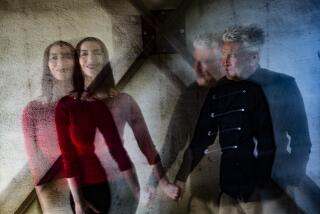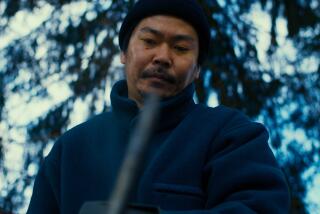Cliff Martinez scores a strange success with ‘Drive’

The cristal baschet is one of the most beautiful musical instruments you will ever see, made of vibrating, tuned steel, fiberglass amplification cones and wire “whiskers” that shimmy when fingers rub the glass-rod keyboard. Film composer Cliff Martinez’s version, which resides in the living room of his Topanga Canyon home, is about the size of an upright piano and is as much sculpture as instrument.
Martinez, whose scores support three films this year, bought his expensive cristal when he was scoring Steven Soderbergh’s surreal 2002 space fantasy “Solaris” but had pined for one as far back as their first collaboration, “Sex, Lies, and Videotape” in 1989. Standing before it, Martinez says nearly every director who sees the instrument falls in love with it — until they hear it beneath a scene. “Then it sounds like either the mothership is landing, or someone’s going to get killed.” In his score to Nicolas Winding Refn’s recently released L.A. noir picture “Drive,” it’s the latter.
To play it, Martinez moistens his fingers in a dish of water, places his hands on the keyboard and starts caressing the glass rods. What emerges is an ethereal moan that suggests a combination of cello and choir of angels. Those who have seen “Drive,” the haunting, sparse ode to Los Angeles’ darker avenues, will immediately recognize its sound and be sent back to a specific scene in an elevator: As Ryan Gosling’s unnamed character defends himself and his girl from a would-be killer, the cristal baschet’s wail, played by Martinez, tempers Gosling’s bloody stomps.
This hum that simmers through “Drive” is a central sonic character in the film and, along with five memorable songs that anchor key scenes and create an analog-disco feel, it helps define the tone of the movie. Though the two other films Martinez worked on this year — “The Lincoln Lawyer” and Soderbergh’s “Contagion” — have each sold about twice as many tickets as “Drive,” it is the soundtrack to “Drive” that has struck a chord with the public. One of the most discussed releases of the year, it is the top-selling soundtrack in America right now and holds the No. 1 spot on iTunes’ soundtrack charts all over the world.
Its success is surprising because the soundtrack is such a curious, quiet and intense collection, one that mixes ice-cold synthesizers with laconic drones that flow into pulsing thumps and eerie tones inspired in part by “The Texas Chainsaw Massacre.” A far cry from the action scores that accompany the typical car movie, the vibe of “Drive” is of early European techno, Brian Eno’s ambient music and longtime David Lynch collaborator Angelo Badalamenti’s wooziness.
After seeing “Drive,” a cruise through downtown Los Angeles — or anywhere, actually — feels different, darker, more sinister. And if the stereo is booming the cristal baschet, or the minimal dance floor thump of Chromatics’ “Tick of the Clock,” which opens the film, or College’s “A Real Hero,” or the ambient swoosh that takes Gosling’s character down Highland past the Hollywood Bowl, an otherwise law-abiding driver will experience the world through the tint of Refn and Martinez’s dark collaboration.
Martinez, 57, is perhaps best known to the public for his early gig as the drummer for Red Hot Chili Peppers (and, earlier, drummer in the final version of Captain Beefheart’s Magic Band) and nearly two dozen films. Refn, born in Denmark and raised in New York, is a director of outsider genre films including the so-called Pusher trilogy, about a group of Scandinavian drug dealers, the 2008 British gangster biopic “Bronson” and 2009’s “Valhalla Rising,” about a Nordic warrior during the Crusades.
Martinez came on late to “Drive,” after the film had been locked with the five songs, a little over a month before its premiere at the Cannes Film Festival in May and with only a temporary score as a reference. He’d been working on “Contagion” but the process had stalled, which opened time in his schedule. He loved what he saw.
“I remember they had the credits and everything. It says, ‘Music by Angelo Badalamenti.’ There was an awkward moment, and then I said, ‘You spelled my name wrong,’” recalls Martinez, laughing. The music in the version he saw was a mix of Eno’s ambient work, “and a very minimalist temp score that was even starker than what I ended up doing — much starker. I said, ‘You came to the right place, because that’s my style.’” (Martinez later said that, to his knowledge, Badalamenti was never tied to the project and that the credit was merely a place holder.)
The first thing Refn asked him was what he thought about the songs. Martinez usually doesn’t like that question. “That’s not my department, and I usually don’t even like to stick my neck out — it’s just not my job, and it’s not my place to even say.”
“I wouldn’t say I fell in love with them at first,” he continues, calling the songs on first impression “peculiar.” “I knew that they were striking, and distinctive, and unique, and not a commercial direction to go in. But I also recognized he was making a strong statement about the film. The pink font was in there, and with that [‘Tick of the Clock’] opening, I knew he built the whole thing around this.”
Martinez’s diplomatic response: “I said, ‘This is your style. This is an integral part of the film. Don’t change a note.’”
For “Drive,” Refn said his “core inspirational source” was influential German electronic pop pioneers Kraftwerk. Once he made this choice, “I can feel the movie. I feel the movie through the music while I’m making it.”
“I don’t use drugs anymore,” added Refn on the phone from Bangkok, Thailand, where he’s filming his follow-up to “Drive.” “And because I’m a fetish filmmaker, I use music to enhance emotions, to come up with images of what I would like to see. But I always have to figure out what the music is. For example, on ‘Bronson,’ I wanted to make an opera, so I listened to a lot of Pet Shop Boys — even though it was designed as an opera. ‘Valhalla Rising’ was very Eistürzende Neubauten — that was the music I was listening to while I was making it.”
You can hear Kraftwerk’s analog synthetic feel throughout “Drive,” even if the group’s music isn’t explicitly used. The stark contrast between shimmering synths, Martinez’s bowed cymbals, odd sound effects, throbbing heartbeat rhythms that pepper the score’s 14 tracks, and the American muscle cars that Gosling roars through downtown’s industrial districts makes for a strange kind of tension. So does the fact that, unlike in most films featuring stunt drivers, Mafia connections and general brutality, the absence of music in the climactic chase scene is as striking as its presence is elsewhere.
“I wanted the sound of the machinery of the engines to be what this chase is about,” explained Refn. “Also, it was a place where you would conventionally use music, and that was interesting where you actually take music away where you expect to hear it. Because the sound itself becomes music, and then you put in music when you don’t expect to hear it, and that becomes sound.”
The biggest mystery at this point for Martinez, though, is how the soundtrack broke through to become a chart-topper. “The only thing I can think of is, one, you kind of had to go with your first take, your first impulse. I certainly was creating music from my subconscious more.”
More to Read
The biggest entertainment stories
Get our big stories about Hollywood, film, television, music, arts, culture and more right in your inbox as soon as they publish.
You may occasionally receive promotional content from the Los Angeles Times.










